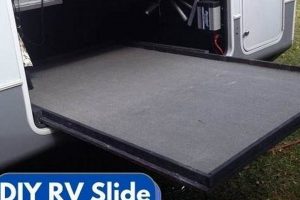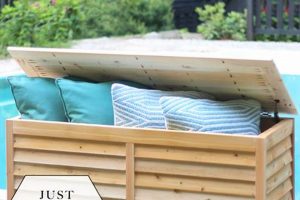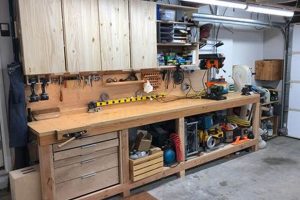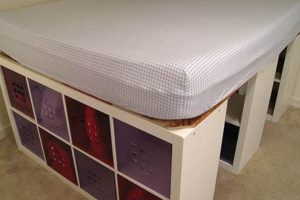Construction of organizational structures using containers and shelving, achieved through individual effort, facilitates efficient space management. This approach involves selecting appropriately sized receptacles, often plastic or metal, and integrating them with shelving units that can be pre-fabricated or assembled from raw materials.
This method offers considerable advantages, including customization to specific spatial dimensions and inventory requirements. Historically, individuals have sought adaptable storage solutions, and the described technique aligns with a desire for cost-effective and personalized organization, frequently seen in residential garages, basements, and workshops. The result allows for visual sorting of items and quick access to frequently used equipment.
The following sections will address various design considerations, material choices, and construction techniques relevant to creating effective and durable systems for structured organization. Discussions will range from simple, freestanding units to more complex, wall-mounted installations, enabling the reader to make informed decisions.
Construction Recommendations
The following recommendations are presented to enhance the durability and functionality of self-constructed storage systems.
Tip 1: Material Selection: Employ shelving materials, such as plywood or steel, that possess sufficient load-bearing capacity to accommodate the anticipated weight of fully loaded containers. Consult load charts to determine appropriate material thickness and support spacing.
Tip 2: Container Dimensions: Prior to constructing the shelving unit, accurately measure the external dimensions of the chosen containers. Account for a slight tolerance to facilitate ease of insertion and removal.
Tip 3: Structural Integrity: Reinforce shelving supports with corner braces or gussets. These additions distribute weight and mitigate potential sagging or collapse under load.
Tip 4: Leveling and Anchoring: Ensure that the shelving unit is perfectly level during installation. Utilize shims if necessary. Secure the unit to the wall using appropriate fasteners to prevent tipping, particularly in areas with seismic activity or where children are present.
Tip 5: Labeling System: Implement a clear and consistent labeling system for each container. This facilitates rapid identification of contents and promotes efficient retrieval.
Tip 6: Ventilation Considerations: For containers storing items susceptible to moisture damage, ensure adequate ventilation within the shelving unit. Consider incorporating ventilation holes in the shelving material or utilizing containers with permeable lids.
Tip 7: Spacing Efficiency: Optimize vertical spacing between shelves to minimize wasted space. Adjustable shelving systems provide the greatest flexibility in accommodating containers of varying heights.
Adherence to these recommendations will contribute to a robust and functional organizational system, extending the lifespan of both the shelving unit and the stored contents.
The subsequent section will explore advanced design concepts and customization options to further enhance the utility and aesthetic appeal of constructed storage solutions.
1. Planning
Effective planning is the cornerstone of successful container-integrated shelving construction. Omission of a comprehensive preparatory stage frequently results in suboptimal space utilization, structural deficiencies, and increased material costs. A well-defined plan addresses crucial elements, including spatial assessment, storage requirements, material selection, and load capacity calculations.
For instance, failing to accurately measure the available space prior to construction may lead to a shelving unit that is either too large or too small for its intended location. Similarly, neglecting to consider the weight of the stored contents can result in structural failure. A case study involving a homeowner who built shelving without adequate load calculations resulted in the collapse of the structure under the weight of stored tools, highlighting the practical significance of meticulous planning. Furthermore, a properly formulated plan incorporates anticipated future needs, enabling a more adaptable and scalable storage solution. Consider an individual who initially builds shelving for lightweight items but later needs to store heavier objects; without prior planning, the existing structure may prove inadequate, necessitating costly modifications or reconstruction.
In conclusion, meticulous planning ensures optimal resource allocation, mitigates potential structural problems, and promotes long-term utility. This initial stage is not merely a preliminary step but a foundational element, essential for achieving a functional and sustainable storage solution.
2. Materials
Material selection is a critical determinant in the durability, load-bearing capacity, and overall lifespan of shelving constructed for container-based storage. The chosen substances directly influence the structural integrity and suitability of the completed system.
- Wood (Plywood, Solid Wood)
Wood offers a balance of strength and aesthetic appeal. Plywood provides cost-effectiveness and dimensional stability, while solid wood grants enhanced durability and a more premium appearance. The selection depends on the anticipated load and the desired aesthetic; for example, a garage shelving unit for heavy tools may require solid wood supports, while a closet system could adequately utilize plywood. Inadequate wood thickness can lead to sagging or collapse under heavy container loads.
- Metal (Steel, Aluminum)
Metal offers high strength-to-weight ratios and resistance to corrosion (depending on the specific alloy and finish). Steel provides exceptional load-bearing capacity, suitable for heavy-duty applications, while aluminum offers a lighter-weight alternative suitable for less demanding environments. Using uncoated steel in a humid environment may lead to rust, compromising structural integrity over time. Conversely, an aluminum frame in a dry storage area could offer a long-lasting, low-maintenance solution.
- Plastics (HDPE, PVC)
Plastics offer resistance to moisture and chemical damage, making them suitable for environments where these factors are prevalent. High-Density Polyethylene (HDPE) exhibits superior impact resistance, while Polyvinyl Chloride (PVC) offers rigidity and ease of fabrication. Employing PVC shelving in an outdoor setting can lead to degradation from UV exposure, while HDPE containers are commonly used for storing corrosive chemicals in industrial settings. Plastic selection hinges on the specific chemical or environmental hazards present.
- Fasteners (Screws, Bolts, Adhesives)
Fasteners ensure structural cohesion. Screws provide ease of assembly and disassembly, bolts offer enhanced shear strength, and adhesives offer seamless bonding for specific materials. Using inappropriate screws for attaching heavy steel supports to wood may result in connection failure under load. Selection criteria must align with material compatibility and load requirements.
The judicious selection of materials, accounting for load requirements, environmental conditions, and aesthetic preferences, is paramount for creating a functional and enduring organization. Neglecting these considerations can lead to premature failure and necessitate costly repairs or replacements.
3. Dimensions
The dimensional aspect is an undeniable component of effective storage construction utilizing bins. The cause-and-effect relationship between carefully considered dimensions and the overall utility of the shelving is significant. Precisely measured dimensions lead to maximized space utilization, ease of access, and a visually coherent structure, while inaccurate measurements result in wasted space, difficulty in retrieving stored items, and an aesthetically displeasing result. The success of any shelving construction hinges on the accuracy with which receptacle measurements are taken and translated into the shelving design.
Consider a scenario where shelves are built without accounting for the slightly tapered design of many plastic receptacles. These receptacles may appear to fit when measured at the top, but will not properly seat on the shelf because the bottom is narrower. The result is wasted vertical space and potentially unstable stacking. Conversely, if shelves are built with excessive clearance, the containers may shift during handling, leading to disorganization. Another practical instance occurs when designing corner shelving; precise angular measurements are paramount to ensure the shelving units seamlessly integrate within the available space. Without accurately accounting for the corner’s angle and depth, the finished product will appear disjointed and fail to maximize storage potential.
In summary, the dimensional attributes of a storage construction are not mere specifications but fundamental components influencing its functionality and aesthetic appeal. Accurate measurement, meticulous planning based on those measurements, and mindful execution during the construction phase are essential to realizing the full potential of a structured organizational system. Failure to prioritize dimension-related accuracy can introduce functional compromises, reducing the efficiency and visual integration of the project.
4. Assembly
The construction of organizational structures utilizing containers and shelving units hinges critically upon the assembly process. The method employed to join the components of the shelving unit directly influences its load-bearing capacity, stability, and longevity. Inadequate assembly techniques can lead to structural failures, rendering the unit unusable and potentially hazardous.
Consider the implications of using improperly sized or spaced fasteners when connecting shelves to vertical supports. If screws are too short or too few in number, the joint will lack sufficient shear strength to support the weight of fully loaded containers. This can manifest as sagging shelves or, in extreme cases, complete structural collapse. Conversely, the use of excessive force during screw installation can strip the threads in the wood, weakening the joint. Another example is the use of glue in conjunction with mechanical fasteners. While glue can enhance joint strength, improper application or selection of an incompatible adhesive can weaken the bond. For metal shelving, welding techniques directly affect the structural integrity of the joints. Poor welds can introduce stress concentrations and lead to premature failure. A case study involving a homeowner who used the incorrect welding rod when assembling a steel shelving unit revealed that the welds cracked under load, requiring complete reconstruction.
In conclusion, the assembly phase is not merely the final step in the construction process; it is a critical determinant of the functional and structural integrity of the finished product. Proper assembly techniques, including the selection of appropriate fasteners, adhesives (where applicable), and welding methods (for metal structures), are essential for achieving a safe, durable, and effective storage solution.
5. Stability
Stability is a paramount consideration in the construction and utilization of organizational structures designed to accommodate storage containers. The inherent safety and long-term effectiveness of these systems are directly contingent upon their ability to resist tipping, collapse, or other forms of structural failure.
- Load Distribution
Uneven weight distribution is a common source of instability. Placing heavier containers on upper shelves or one side of the unit creates a torque force, increasing the risk of tipping. Distributing weight evenly across all shelves and minimizing the load on upper levels significantly enhances stability. For example, a shelving unit with dense metal components stored on the top shelf is at far greater risk of toppling than the same unit with lighter plastic containers stored at that location. This principle also extends to the placement of objects within the containers themselves, as concentrated weight can exacerbate instability.
- Anchoring Mechanisms
Securing the shelving unit to a wall or floor provides critical supplemental support. Wall anchors, appropriately sized for the wall material, prevent tipping. Floor anchors, particularly in situations involving freestanding units, provide a more substantial and permanent form of stabilization. A shelving unit containing valuable or hazardous materials should invariably be secured to prevent accidental displacement during seismic events or accidental impact.
- Material Rigidity
The inherent rigidity of the shelving materials directly contributes to overall stability. Flexible or weak materials, such as thin particleboard, are prone to bending and sagging under load, compromising the structural integrity of the unit. Utilizing materials with sufficient thickness and strength, such as solid wood or steel, provides a more robust and stable platform. This is especially important for shelving designed to hold heavy or bulky items.
- Base Design
The design of the base or supporting structure is crucial for stability, especially in freestanding units. A wider base provides a greater area of support, reducing the likelihood of tipping. Adjustable leveling feet compensate for uneven floor surfaces, ensuring that the unit rests firmly on the ground. A narrow base, conversely, is inherently less stable and more susceptible to tipping, particularly if the unit is subjected to external forces.
These facets highlight the interconnectedness of design, material selection, and installation practices in ensuring the stability of organizational systems that rely on container storage. A systematic approach to these considerations is essential for creating safe and functional structures that maximize storage potential while minimizing the risk of accidents or structural failure.
6. Accessibility
Accessibility is a fundamental design consideration within container-based organizational structures. The capacity to readily retrieve and replace stored items directly impacts the efficiency and usability of the entire system. A shelving unit, regardless of its structural integrity or aesthetic appeal, is functionally deficient if the stored containers are difficult to reach, view, or manipulate. The ergonomic principles dictating ease of access significantly influence user satisfaction and sustained adherence to organizational practices.
Instances where accessibility is compromised commonly stem from inadequate planning or design oversights. For example, positioning frequently used receptacles on the highest shelves necessitates repetitive reaching and straining, potentially leading to physical discomfort or injury. Conversely, storing heavy items on lower shelves, while beneficial for stability, can create difficulties in lifting and maneuvering. The implementation of pull-out shelving or rotating platforms mitigates such issues, allowing for effortless retrieval regardless of receptacle weight or vertical positioning. Clear labeling systems further enhance accessibility by enabling rapid identification of contents, reducing the need to manually inspect each container. A storage system in a manufacturing setting with parts labeled clearly for specific production lines exemplifies this. This approach increases productivity and lowers the risk of errors.
Effective strategies for enhancing accessibility include optimizing shelf height to accommodate the reach range of the primary user, ensuring adequate clearance around the shelving unit for movement, and implementing visual cues to facilitate identification. These considerations transform storage from a passive holding space into an active component of daily workflow. Proper design requires careful consideration of reach, strength, and mobility, contributing to a safer and more usable environment.
7. Customization
Customization represents a core tenet of self-constructed storage solutions. This principle underscores the adaptation of shelving units to precisely match spatial constraints, storage requirements, and aesthetic preferences. This inherent flexibility distinguishes “storage bin shelving diy” from mass-produced alternatives, offering advantages in space optimization and tailored functionality. The effect of customization is a system that seamlessly integrates into its environment and precisely addresses the organizational needs of the end user.The significance of customization stems from the variability in storage requirements across different environments. A residential garage necessitates different dimensions and load capacities than a pantry or a retail stockroom. Tailoring the shelf height, depth, and width to accommodate specific receptacle sizes minimizes wasted space and enhances accessibility. The ability to select materials based on environmental conditions, such as moisture resistance in a basement or chemical resistance in a workshop, further enhances the longevity and utility of the storage system.
Practical applications of customization range from simple adjustments to fully bespoke designs. A basic adaptation may involve varying shelf spacing to accommodate receptacles of different heights. A more complex example is the construction of shelving units designed to fit within irregularly shaped spaces, such as under staircases or in alcoves. In commercial environments, customization might involve integrating specialized features, such as angled shelves for displaying retail products or ventilated shelves for storing perishable items.The economic implications of customization are also noteworthy. While the initial investment in materials and tools may be higher than purchasing pre-fabricated shelving, the long-term benefits of efficient space utilization and extended system lifespan often outweigh the upfront costs. Moreover, the ability to modify or expand the storage system as needs evolve provides a cost-effective alternative to replacing the entire unit.
In summary, customization stands as a defining characteristic of container-integrated shelving. It enables the creation of storage solutions that are precisely tailored to specific needs and environments. Challenges associated with customization include the requirement for careful planning, accurate measurements, and skilled execution. However, the benefits of optimized space utilization, enhanced functionality, and extended system lifespan justify the effort. The trend toward personalized solutions suggests that customization will remain a central element in the evolution of organizational systems.
Frequently Asked Questions
The following elucidates common inquiries regarding self-constructed container shelving. The intent is to provide clarity on technical aspects and address prevalent misconceptions.
Question 1: What is the recommended spacing between shelf supports for heavy-duty plastic storage containers?
The optimal spacing depends on the material and thickness of the shelving material. For plywood shelving with a thickness of 3/4 inch, a support spacing of no more than 36 inches is recommended. Steel shelving can accommodate greater spans, but consulting load tables is advised.
Question 2: How is the likelihood of shelving unit tipping mitigated, particularly in homes with children?
Shelving units should be securely anchored to the wall using appropriate hardware. Wall anchors rated for the anticipated load are essential. Distributing heavier containers on lower shelves reduces the center of gravity and further enhances stability.
Question 3: What materials are most resistant to moisture damage in damp environments such as basements?
Plastic or metal shelving with a corrosion-resistant coating is recommended. Avoid untreated wood or particleboard, as these materials are susceptible to water absorption and subsequent degradation. Consider using containers with tight-fitting lids to further protect contents from moisture.
Question 4: Is pre-fabricated shelving superior to self-constructed shelving in terms of structural integrity?
Neither option is inherently superior. Structural integrity depends on design and material quality. Self-constructed shelving allows for customization, while pre-fabricated options offer convenience and potentially lower initial costs. Rigorous adherence to engineering standards is imperative regardless of the chosen approach.
Question 5: What are the implications of using containers of varying sizes within a single shelving unit?
Employing containers of dissimilar dimensions can lead to inefficient space utilization. Planning for container compatibility during the design phase optimizes vertical space and prevents wasted volume. Adjustable shelving offers enhanced flexibility in accommodating containers of varying heights.
Question 6: How can proper ventilation be ensured within shelving units used for storing items susceptible to mold or mildew growth?
Incorporate ventilation holes into the shelving material to promote air circulation. Avoid tightly packing containers together, as this restricts airflow. Desiccant packs can absorb moisture and further reduce the risk of mold or mildew. Periodic inspection for signs of moisture or mold growth is recommended.
In essence, the successful implementation of storage container shelving requires careful planning, appropriate material selection, and adherence to sound construction principles. Addressing the above questions proactively helps avert common pitfalls.
The subsequent section presents advanced design concepts to further refine the organizational impact of custom-built storage.
Conclusion
The preceding analysis has demonstrated that the self-directed construction of shelving, integrated with storage containers, represents a multifaceted endeavor. Effective “storage bin shelving diy” demands attention to spatial planning, material selection, structural integrity, accessibility, and customization. The process, while offering significant advantages in tailoring solutions to individual needs, also necessitates a rigorous approach to design and execution to ensure both functionality and safety.
As organizational demands evolve and space constraints persist, continued innovation in “storage bin shelving diy” techniques remains crucial. Individuals and organizations seeking to optimize storage capacity and streamline operations must consider the principles outlined herein, adopting a proactive and informed approach to maximize the utility and longevity of their storage systems. Prioritization of these factors will yield significant returns in efficiency and resource management.


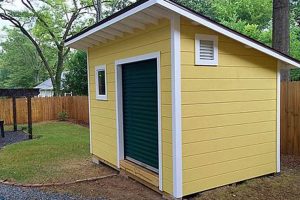
![DIY Storage: Tote Rack DIY Plans & Ideas [Easy!] The DIY Hub: Creative Crafts, Repairs & Life Hacks DIY Storage: Tote Rack DIY Plans & Ideas [Easy!] | The DIY Hub: Creative Crafts, Repairs & Life Hacks](https://craftingdiycenter.com/wp-content/uploads/2025/07/th-1813-300x200.jpg)
